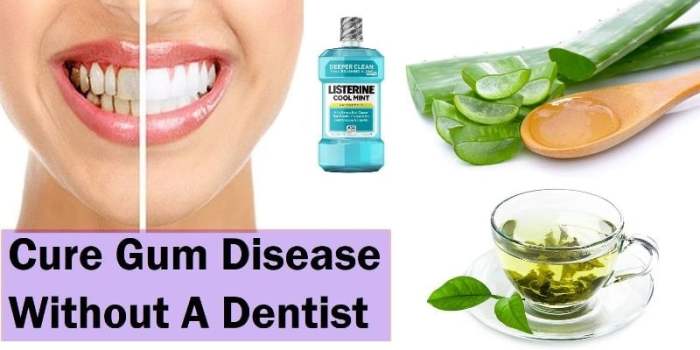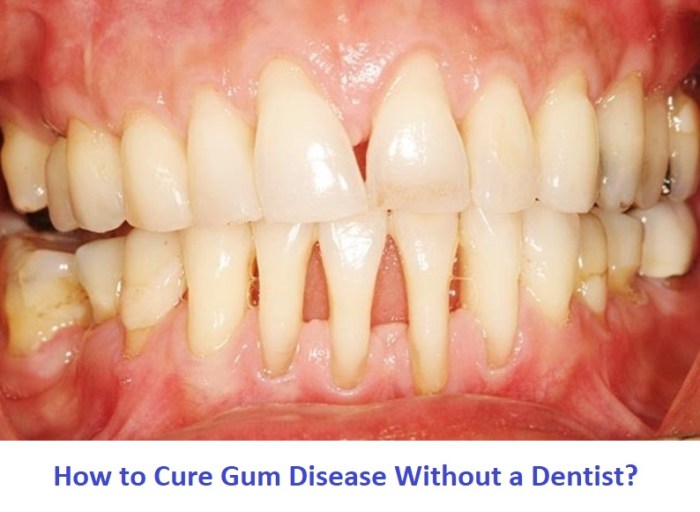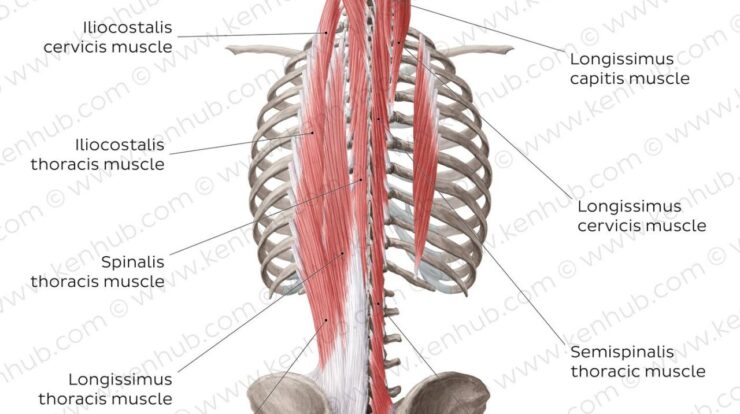
How to cure gum disease without a dentist – Ready to bid farewell to gum disease without relying on a dentist? This comprehensive guide empowers you with home remedies, over-the-counter solutions, and lifestyle tweaks to restore your oral health and keep your gums gleaming.
From the comfort of your own home, you’ll discover how to harness the healing power of natural ingredients, choose the right over-the-counter remedies, and implement dietary changes that promote gum health.
Home Remedies and Natural Treatments
Gum disease is a common problem that can be caused by a variety of factors, including poor oral hygiene, smoking, and certain medical conditions. While there are a number of effective treatments for gum disease, some people may prefer to try home remedies and natural treatments.
There are a number of effective home remedies for gum disease. One of the most common is to rinse your mouth with salt water. Salt water helps to reduce inflammation and kill bacteria. To make a salt water rinse, simply dissolve 1/2 teaspoon of salt in 8 ounces of warm water.
Rinse your mouth with the salt water for 30 seconds, then spit it out.
Another effective home remedy for gum disease is to apply baking soda to your gums. Baking soda helps to neutralize acids and kill bacteria. To apply baking soda to your gums, simply dip a wet toothbrush into baking soda and brush your gums gently.
Rinse your mouth with water after brushing.
Turmeric is another natural ingredient that has been shown to be effective in treating gum disease. Turmeric contains curcumin, a compound that has anti-inflammatory and antibacterial properties. To use turmeric for gum disease, simply mix 1/2 teaspoon of turmeric powder with 1/2 teaspoon of water to form a paste.
Apply the paste to your gums and leave it on for 10 minutes. Rinse your mouth with water after 10 minutes.
While home remedies and natural treatments can be effective in treating gum disease, it is important to note that they are not a substitute for professional dental care. If you have gum disease, it is important to see a dentist to get a proper diagnosis and treatment plan.
Over-the-Counter Remedies: How To Cure Gum Disease Without A Dentist

Over-the-counter (OTC) products can provide temporary relief from gum disease symptoms. These products contain ingredients that reduce inflammation and kill bacteria, helping to improve gum health. Choosing the right OTC remedy depends on the severity of your symptoms and the specific ingredients you prefer.
Mouthwashes
OTC mouthwashes are a common choice for treating gum disease. They contain active ingredients like chlorhexidine, cetylpyridinium chloride (CPC), and triclosan, which kill bacteria and reduce inflammation. Chlorhexidine is particularly effective against bacteria that cause gum disease, but it can cause staining and bitter taste.
Gels
OTC gels are applied directly to the affected areas of the gums. They contain ingredients like hydrogen peroxide, which kills bacteria and helps reduce inflammation. Gels can be more targeted than mouthwashes, but they may be less convenient to use.
Rinses
OTC rinses are similar to mouthwashes, but they are typically used less frequently. They contain ingredients like fluoride, which helps strengthen teeth and prevent cavities, and essential oils, which have antibacterial and anti-inflammatory properties.
Dietary Modifications

Dietary modifications play a crucial role in preventing and managing gum disease. Consuming a balanced diet rich in certain nutrients and avoiding harmful foods and beverages can significantly improve oral health and reduce inflammation in the gums.
Foods and Beverages that Promote Oral Health
Incorporate these foods and beverages into your diet to support gum health:
- Fruits and Vegetables:Fruits and vegetables, particularly leafy greens, citrus fruits, and berries, are rich in antioxidants, vitamins, and minerals that strengthen the immune system and reduce inflammation.
- Lean Protein:Lean protein sources, such as fish, poultry, and beans, provide essential amino acids that help repair and maintain gum tissue.
- Dairy Products:Dairy products, including milk, cheese, and yogurt, contain calcium, which strengthens teeth and bones and reduces the risk of gum disease.
- Green Tea:Green tea contains polyphenols, powerful antioxidants that have antibacterial and anti-inflammatory properties.
- Water:Staying hydrated helps flush away bacteria and food particles from the mouth, reducing the risk of plaque buildup and gum inflammation.
Foods and Drinks to Avoid
Limit or avoid these foods and drinks to improve gum health:
- Sugary Foods and Drinks:Sugary foods and drinks feed the bacteria in the mouth, leading to plaque formation and gum inflammation.
- Processed Foods:Processed foods are often high in unhealthy fats, sodium, and sugar, which can contribute to gum disease.
- Alcohol:Alcohol consumption can dehydrate the mouth and reduce saliva production, creating a favorable environment for bacteria.
- Tobacco Products:Smoking and chewing tobacco damage the gums and increase the risk of gum disease.
Oral Hygiene Techniques
Maintaining proper oral hygiene is crucial for preventing and treating gum disease. This involves adopting effective brushing and flossing techniques, utilizing interdental brushes or water flossers, and scheduling regular dental checkups and professional cleanings.
Gum disease can be a real pain in the gums, but you don’t always have to see a dentist to cure it. There are plenty of home remedies you can try, like gargling with salt water or using a hydrogen peroxide rinse.
If you’re looking for more information on how to cure gum disease without a dentist, check out Los Angeles Mecconline . They have a great article that covers all the basics, from symptoms to treatment options. And if you’re still having trouble, they offer a free consultation with a licensed dentist.
Brushing and Flossing Techniques
To effectively remove plaque and bacteria, follow these steps when brushing and flossing:
- Brush twice daily:Use a soft-bristled toothbrush and fluoride toothpaste. Brush for at least two minutes, covering all surfaces of your teeth.
- Floss daily:Flossing removes plaque and bacteria from between teeth where your toothbrush can’t reach. Use a gentle sawing motion to avoid damaging your gums.
- Angle the toothbrush:Hold your toothbrush at a 45-degree angle to your gum line. This allows the bristles to reach below the gum line and remove plaque.
- Use a circular motion:Gently move the toothbrush in small circular motions to loosen plaque and bacteria.
- Don’t overbrush:Brushing too hard can damage your gums and enamel. Use gentle pressure and avoid scrubbing.
Interdental Brushes and Water Flossers
Interdental brushes and water flossers can help clean areas between teeth and below the gum line that are difficult to reach with a toothbrush and floss.
- Interdental brushes:These small brushes are inserted between teeth to remove plaque and bacteria. Choose a brush size that fits snugly between your teeth.
- Water flossers:These devices use a stream of water to remove plaque and bacteria from between teeth and below the gum line. They can be particularly effective for people with braces or other dental appliances.
Regular Dental Checkups and Professional Cleanings, How to cure gum disease without a dentist
Regular dental checkups and professional cleanings are essential for maintaining good oral health and preventing gum disease.
- Dental checkups:Visit your dentist every six months for a checkup. Your dentist will examine your teeth and gums for signs of gum disease and other oral health problems.
- Professional cleanings:Professional cleanings remove plaque and tartar that you can’t remove on your own. They help prevent gum disease and keep your teeth and gums healthy.
Lifestyle Habits
Gum disease can be exacerbated by certain lifestyle habits. Understanding the impact of these habits and taking steps to modify them can significantly improve oral health.
Smoking and excessive alcohol consumption can damage the gums and increase the risk of gum disease. Smoking impairs the immune system’s ability to fight off bacteria, while alcohol dries out the mouth, reducing saliva production and increasing the risk of gum infection.
Quitting smoking and reducing alcohol intake are crucial for maintaining good oral hygiene.
Stress Management
Stress can contribute to gum disease by weakening the immune system and reducing saliva production. Chronic stress can lead to hormonal imbalances that affect the body’s response to infection, making it more susceptible to gum disease. Techniques such as exercise, yoga, meditation, and deep breathing can help manage stress levels and improve overall oral health.
Conclusive Thoughts
By embracing the strategies Artikeld in this guide, you’ll not only alleviate gum disease but also cultivate a healthier smile. Remember, prevention is key, so make these practices a part of your daily routine and enjoy a lifetime of vibrant oral health.
FAQ Insights
Can I cure gum disease completely on my own?
While home remedies and lifestyle changes can significantly improve gum health, it’s crucial to consult a dentist for proper diagnosis and treatment if the condition is severe or persistent.
How long does it take to cure gum disease naturally?
The duration varies depending on the severity of the disease and your individual response to treatment. With consistent effort, you may notice improvements within a few weeks to months.
Is it possible to prevent gum disease?
Absolutely! Maintaining good oral hygiene, eating a balanced diet, and avoiding smoking and excessive alcohol consumption can go a long way in preventing gum disease.





